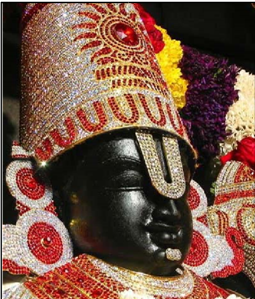Talk:The Āḻvār Saints:Anantācārya (12th century CE)
By Vishal Agarwal
Every morning, a white paste made of camphor is applied to the chin of the mūrti of Balaji in the Tirupati Mandir. This tradition is said to have begun several hundred years ago.
At that time, Saint Ananthāchārya and his wife tended the garden around the Mandir and collected flowers for garlands to offer to the mūrti. One day, while working in the garden, Ananthāchārya’s wife felt very tired because she was expecting a child. Suddenly, a young boy appeared and began helping her with the work.
When Ananthāchārya saw the boy, he became suspicious and thought the boy was a thief. He ran after him and hurled his spade towards him. The spade struck the boy’s chin, causing it to bleed. The boy immediately ran into the Mandir and disappeared from sight.
The next day, when Ananthāchārya went to offer the garland to the mūrti, he was shocked to see that the chin of the mūrti was bleeding at the exact spot where the spade had struck the boy. Realising that the boy was none other than Bhagavān himself, Ananthāchārya was filled with remorse and sought forgiveness. To stop the bleeding and soothe the chin, he applied a paste of camphor.
From that day onwards, applying camphor paste to the chin of the mūrti of Balaji became a daily custom at the Tirupati Mandir, continuing to this very day.

